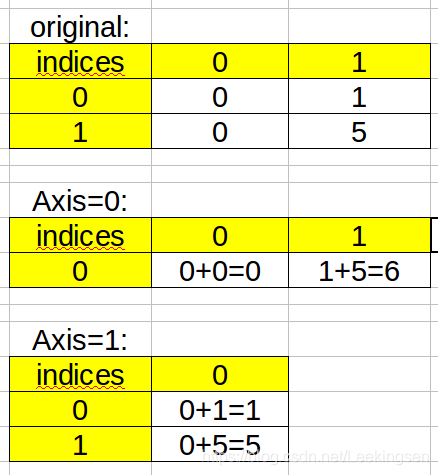numpy的sum函数可接受的参数是:
sum(a, axis=None, dtype=None, out=None, keepdims=np._NoValue)
- a : array_like elements to sum.
- axis : None or int or tuple of ints, optional
- Axis or axes along which a sum is performed.
- The default, axis=None, will sum all of the elements of the input array.
- If axis is negative it counts from the last to the first axis.
- If axis is a tuple of ints, a sum is performed on all of the axes
- specified in the tuple instead of a single axis or all the axes as before.
在参数列表中:
a:用于进行加法运算的数组形式的元素/是要进行加法运算的向量/数组/矩阵
axis:的值可以为None,也可以为整数和元组
根据上文,可知:
axis的取值有三种情况:1.None,2.整数, 3.整数元组。
(在默认/缺省的情况下,axis取None)
如果axis取None,即将数组/矩阵中的元素全部加起来,得到一个和。
Example:
>>> np.sum([0.5, 1.5])2.0>>> np.sum([0.5, 0.7, 0.2, 1.5], dtype=np.int32)1>>> np.sum([[0, 1], [0, 5]])6
如果axis为整数,axis的取值不可大于数组/矩阵的维度,且axis的不同取值会产生不同的结果。
先以2×2的二维矩阵为例:
>>> np.sum([[0, 1], [0, 5]], axis=0)array([0, 6])>>> np.sum([[0, 1], [0, 5]], axis=1)array([1, 5])
在上述例子中
当axis为0时,是压缩行,即将每一列的元素相加,将矩阵压缩为一行
当axis为1时,是压缩列,即将每一行的元素相加,将矩阵压缩为一列(这里的一列是为了方便理解说的,实际上,在控制台的输出中,仍然是以一行的形式输出的)
具体理解如图:
当axis取负数的时候,对于二维矩阵,只能取-1和-2(不可超过矩阵的维度)。
当axis=-1时,相当于axis=1的效果,当axis=-2时,相当于axis=0的效果。
如果axis为整数元组(x,y),则是求出axis=x和axis=y情况下得到的和。
继续以上面的2×2矩阵为例
>>>np.sum([[0,1],[0,5]],axis=(0,1))>>>6>>>np.sum([[0,1],[0,5]],axis=(1,0))>>>6
另外,需要注意的是:如果要输入两个数组/矩阵/向量进行相加,那么就要先把两个数组/矩阵/向量用一个括号括起来,形成一个元组,这样才能够进行相加。因为numpy.sum的运算实现本质是通过矩阵内部的运算实现的。
当然,如果只是向量/数组之间做加法运算,可以直接让两个向量/数组相加,但前提是它们必须为numpy的array数组才可以,否则只是单纯的列表相加
Example:
>>>v1 = [1, 2]>>>v2 = [3, 4]>>>v1 + v2[1, 2, 3, 4]>>>v1 = numpy.array[1, 2]>>>v2 = numpy.array[3, 4]>>>v1 + v2[4, 6]
————————————————
版权声明:本文为CSDN博主「Leekingsen」的原创文章,遵循CC 4.0 BY-SA版权协议,转载请附上原文出处链接及本声明。
原文链接:https://blog.csdn.net/Leekingsen/article/details/76242244

